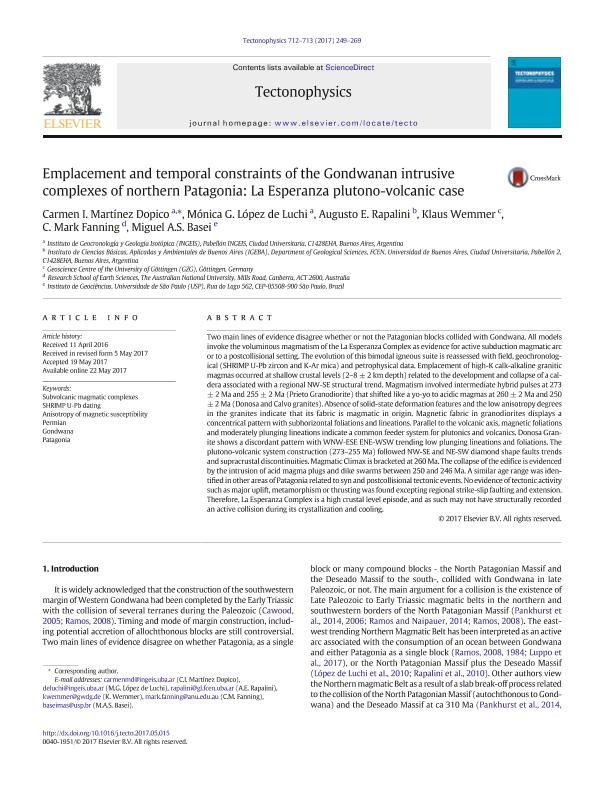Mostrar el registro sencillo del ítem
dc.contributor.author
Martínez Dopico, Carmen Irene

dc.contributor.author
Lopez, Monica Graciela

dc.contributor.author
Rapalini, Augusto Ernesto

dc.contributor.author
Wemmer, Klaus

dc.contributor.author
Fanning, Mark
dc.contributor.author
Basei, Miguel A. S.
dc.date.available
2017-07-17T16:33:14Z
dc.date.issued
2017-05
dc.identifier.citation
Martínez Dopico, Carmen Irene; Lopez, Monica Graciela; Rapalini, Augusto Ernesto; Wemmer, Klaus; Fanning, Mark; et al.; Emplacement and temporal constraints of the Gondwanan intrusive complexes of northern Patagonia: La Esperanza plutono-volcanic case; Elsevier Science; Tectonophysics; 712; 5-2017; 249-269
dc.identifier.issn
0040-1951
dc.identifier.uri
http://hdl.handle.net/11336/20699
dc.description.abstract
Two main lines of evidence disagree whether or not the Patagonian blocks collided with Gondwana. All models invoke the voluminous magmatism of the La Esperanza Complex as evidence for active subduction magmatic arc or to a postcollisional setting. The evolution of this bimodal igneous suite is reassessed with field, geochronological (SHRIMP U-Pb zircon and K-Ar mica) and petrophysical data. Emplacement of high-K calk-alkaline granitic magmas occurred at shallow crustal levels (2–8 ± 2 km depth) related to the development and collapse of a caldera associated with a regional NW-SE structural trend. Magmatism involved intermediate hybrid pulses at 273 ± 2 Ma and 255 ± 2 Ma (Prieto Granodiorite) that shifted like a yo-yo to acidic magmas at 260 ± 2 Ma and 250 ± 2 Ma (Donosa and Calvo granites). Absence of solid-state deformation features and the low anisotropy degrees in the granites indicate that its fabric is magmatic in origin. Magnetic fabric in granodiorites displays a concentrical pattern with subhorizontal foliations and lineations. Parallel to the volcanic axis, magnetic foliations and moderately plunging lineations indicate a common feeder system for plutonics and volcanics. Donosa Granite shows a discordant pattern with WNW-ESE ENE-WSW trending low plunging lineations and foliations. The plutono-volcanic system construction (273–255 Ma) followed NW-SE and NE-SW diamond shape faults trends and supracrustal discontinuities. Magmatic Climax is bracketed at 260 Ma. The collapse of the edifice is evidenced by the intrusion of acid magma plugs and dike swarms between 250 and 246 Ma. A similar age range was identified in other areas of Patagonia related to syn and postcollisional tectonic events. No evidence of tectonic activity such as major uplift, metamorphism or thrusting was found excepting regional strike-slip faulting and extension. Therefore, La Esperanza Complex is a high crustal level episode, and as such may not have structurally recorded an active collision during its crystallization and cooling.
dc.format
application/pdf
dc.language.iso
eng
dc.publisher
Elsevier Science

dc.rights
info:eu-repo/semantics/openAccess
dc.rights.uri
https://creativecommons.org/licenses/by-nc-nd/2.5/ar/
dc.subject
Gondwana
dc.subject
Patagonia
dc.subject.classification
Otras Ciencias de la Tierra y relacionadas con el Medio Ambiente

dc.subject.classification
Ciencias de la Tierra y relacionadas con el Medio Ambiente

dc.subject.classification
CIENCIAS NATURALES Y EXACTAS

dc.title
Emplacement and temporal constraints of the Gondwanan intrusive complexes of northern Patagonia: La Esperanza plutono-volcanic case
dc.type
info:eu-repo/semantics/article
dc.type
info:ar-repo/semantics/artículo
dc.type
info:eu-repo/semantics/publishedVersion
dc.date.updated
2017-07-13T18:31:21Z
dc.journal.volume
712
dc.journal.pagination
249-269
dc.journal.pais
Países Bajos

dc.journal.ciudad
Amsterdam
dc.description.fil
Fil: Martínez Dopico, Carmen Irene. Consejo Nacional de Investigaciones Científicas y Técnicas. Oficina de Coordinación Administrativa Ciudad Universitaria. Instituto de Geocronología y Geología Isotopica. Universidad de Buenos Aires. Facultad de Ciencias Exactas y Naturales. Instituto de Geocronología y Geología Isotópica; Argentina
dc.description.fil
Fil: Lopez, Monica Graciela. Consejo Nacional de Investigaciones Científicas y Técnicas. Oficina de Coordinación Administrativa Ciudad Universitaria. Instituto de Geocronología y Geología Isotopica. Universidad de Buenos Aires. Facultad de Ciencias Exactas y Naturales. Instituto de Geocronología y Geología Isotópica; Argentina
dc.description.fil
Fil: Rapalini, Augusto Ernesto. Consejo Nacional de Investigaciones Científicas y Técnicas. Oficina de Coordinación Administrativa Ciudad Universitaria. Instituto de Geociencias Basicas, Aplicadas y Ambientales de Buenos Aires. Universidad de Buenos Aires. Facultad de Ciencias Exactas y Naturales. Instituto de Geociencias Basicas, Aplicadas y Ambientales de Buenos Aires; Argentina
dc.description.fil
Fil: Wemmer, Klaus. Universität Göttingen; Alemania
dc.description.fil
Fil: Fanning, Mark. Australian National University; Australia
dc.description.fil
Fil: Basei, Miguel A. S.. Universidade de Sao Paulo; Brasil
dc.journal.title
Tectonophysics

dc.relation.alternativeid
info:eu-repo/semantics/altIdentifier/doi/http://dx.doi.org/10.1016/j.tecto.2017.05.015
dc.relation.alternativeid
info:eu-repo/semantics/altIdentifier/url/http://www.sciencedirect.com/science/article/pii/S0040195117301981
Archivos asociados
